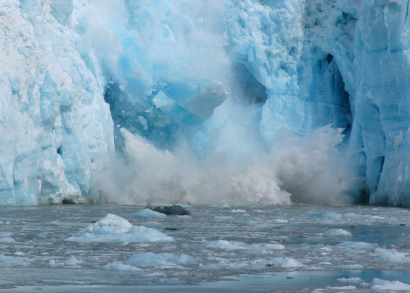A Threat To Humanity...
|
Glaciers are Receding at an Alrming Rate!!!
India also witnessed alternate wet and dry periods. Archaeological findings show that the Rajasthan desert experienced wet and cool climate around 8,000 B.C. The period 3,000- 1,700 B.C. had higher rainfall. From about 2,000-1,700 B.C., this region was the centre of the Harappan civilisation. Dry conditions accentuated since then. In the geological past, the earth was warm some 500-300 million years ago, through the Cambrian, Ordovician and Silurian periods. During the Pleistocene epoch, glacial and inter-glacial periods occurred, the last major peak glacial period was about 18,000 years ago. The present inter-glacial period started 10,000 years ago.
|
Climate In Recent PastVariability in climate occurs all the time. The nineties decade of the last century witnessed extreme weather events. The 1990s recorded the warmest temperature of the century and some of the worst floods around the world. The worst devastating drought in the Sahel region, south of the Sahara desert, from 1967-1977 is one such variability. During the 1930s, severe drought occurred in southwestern Great Plains of the United States, described as the dust bowl. Historical records of crop yield or crop failures, of floods and migration of people tell about the effects of changing climate. A number of times Europe witnessed warm, wet, cold and dry periods, the significant episodes were the warm and dry conditions in the tenth and eleventh centuries, when the Vikings settled in Greenland. Europe witnessed “Little Ice Age” from 1550 to about 1850. From about 1885-1940 world temperature showed an upward trend. After 1940, the rate of increase in temperature slowed down. Causes of Climate ChangeThe causes for climate change are many. They can be grouped into astronomical and terrestrial causes. The astronomical causes are the changes in solar output associated with sunspot activities. Sunspots are dark and cooler patches on the sun which increase and decrease in a cyclical manner. According to some meteorologists, when the number of sunspots increase, cooler and wetter weather and greater storminess occur. A decrease in sunspot numbers is associated with warm and drier conditions. Yet, these findings are not statistically significant. An another astronomical theory is Millankovitch oscillations, which infer cycles in the variations in the earth’s orbital characteristics around the sun, the wobbling of the earth and the changes in the earth’s axial tilt. All these alter the amount of insolation received from the sun, which in turn, might have a bearing on the climate. |
Climate Change: Causes / Global Warming
Volcanism is considered as another cause for climate change. Volcanic eruption throws up lots of aerosols into the atmosphere. These aerosols remain in the atmosphere for a considerable period of time reducing the sun’s radiation reaching the Earth’s surface. After the recent Pinatoba and El Cion volcanic eruptions, the average temperature of the earth fell to some extent for some years.The most important anthropogenic effect on the climate is the increasing trend in the concentration of greenhouse gases in the atmosphere which is likely to cause global warming.
Due to the presence of greenhouse gases, the atmosphere is behaving like a greenhouse. The atmosphere also transmits the incoming solar radiation but absorbs the vast majority of long wave radiation emitted upwards by the earth’s surface. The gases that absorb long wave radiation are called greenhouse gases. The processes that warm the atmosphere are often collectively referred to as the greenhouse effect
The primary GHGs of concern today are carbon dioxide (CO2),Chlorofluorocarbons (CFCs), methane (CH4),nitrous oxide (N2O) and ozone (O3). Some other gases such as nitric oxide (NO) and carbon monoxide (CO) easily react with GHGs and affect their concentration in the atmosphere. The effectiveness of any given GHG molecule will depend on the magnitude of the increase in its concentration, its life time in the atmosphere and the wavelength of radiation that it absorbs. The chlorofluorocarbons (CFCs) are highly effective. Ozone which absorbs ultra violet radiation in the stratosphere is very effective in absorbing terrestrial radiation when it is present in the lower troposphere. Another important point to be noted is that the more time the GHG molecule remains in the atmosphere, the longer it will take for earth’s atmospheric system to recover from any change brought about by the latter. The largest concentration of GHGs in the atmosphere is carbon dioxide. The emission of CO2 comes mainly from fossil fuel combustion (oil, gas and coal). Forests and oceans are the sinks for the carbon dioxide. Forests use CO2 in their growth. So, deforestation due to changes in land use, also increases the concentration of Co2. The time taken for atmospheric CO2 to adjust to changes in sources to sinks is 20-50 years. It is rising at about 0.5 per cent annually. Doubling of concentration of CO2 over pre-industrial level is used as an index for estimating the changes in climate in climatic models.
Chlorofluorocarbons (CFCs) are products of human activity. Ozone occurs in the stratosphere where ultra-violet rays convert oxygen into ozone. Thus, ultra violet rays do not reach the earth’s surface. The CFCs which drift into the stratosphere destroy the ozone. Large depletion of ozone occurs over Antarctica. The depletion of ozone concentration in the stratosphere is called the ozone hole. This allows the ultra violet rays to pass through the troposphere. International efforts have been initiated for reducing the emission of GHGs into the atmosphere. The most important one is the Kyoto protocol proclaimed in 1997. This protocol went into effect in 2005, ratified by 141 nations. Kyoto protocol bounds the 35 industrialised countries to reduce their emissions by the year 2012 to 5 per cent less than the levels prevalent in the year 1990. The increasing trend in the concentration of GHGs in the atmosphere may, in the long run, warm up the earth. Once the global warming sets in, it will be difficult to reverse it. The effect of global warming may not be uniform everywhere. Nevertheless, the adverse effect due to global warming will adversely affect the life supporting system. Rise in the sea level due to melting of glaciers and ice-caps and thermal expansion of the sea may inundate large parts of the coastal area and islands, leading to social problems. This is another cause for serious concern for the world community. Efforts have already been initiated to control the emission of GHGs and to arrest the trend towards global warming. Let us hope the world community responds to this challenge and adopts a lifestyle that leaves behind a livable world for the generations to come. One of the major concerns of the world today is global warming. Let us look at how much the planet has warmed up from the temperature records.
Temperature data are available from the middle of the 19th century mostly for western Europe. The reference period for this study is 1961-90. The temperature anomalies for the earlier and later periods are estimated from the average temperature for the period 1961-90. The annual average near-surface air temperature of the world is approximately 14°C. The time series show anomalies of annual near surface temperature over land from 1856-2000, relative to the period 1961-90 as normal for the globe. An increasing trend in temperature was discernible in the 20th century. The greatest warming of the 20th century was during the two periods, 1901-44 and 1977-99. Over each of these two periods, global temperatures rose by about 0.4°C. In between, there was a slight cooling, which was more marked in the Northern Hemisphere. The globally averaged annual mean temperature at the end of the 20th century was about 0.6°C above that recorded at the end of the 19th century. The seven warmest years during the 1856-2000 were recorded in the last decade.
The year 1998 was the warmest year, probably not only for the 20th century but also for the whole millennium.


 The type of climate we experience now might
be prevailing over the last 10,000 years with
minor and occasionally wide fluctuations. The
planet earth has witnessed many variations in
climate since the beginning. Geological records
show alteration of glacial and inter-glacial
periods. The geomorphological features,
especially in high altitudes and high latitudes,
exhibit traces of advances and retreats of
glaciers. The sediment deposits in glacial lakes
also reveal the occurrence of warm and cold
periods. The rings in the trees provide clues
about wet and dry periods. Historical records
describe the vagaries in climate. All these
evidences indicate that change in climate is a
natural and continuous process.
The type of climate we experience now might
be prevailing over the last 10,000 years with
minor and occasionally wide fluctuations. The
planet earth has witnessed many variations in
climate since the beginning. Geological records
show alteration of glacial and inter-glacial
periods. The geomorphological features,
especially in high altitudes and high latitudes,
exhibit traces of advances and retreats of
glaciers. The sediment deposits in glacial lakes
also reveal the occurrence of warm and cold
periods. The rings in the trees provide clues
about wet and dry periods. Historical records
describe the vagaries in climate. All these
evidences indicate that change in climate is a
natural and continuous process.